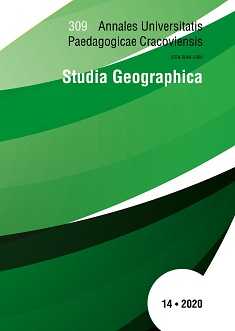Geography at a secondary school – challenges and reality
DOI:
https://doi.org/10.24917/20845456.14.7Keywords:
geographical education at a secondary school, students’ competences, education reform in PolandAbstract
In connection with a thorough reform of the education system in Poland undertaken in recent years, a special attention has been paid to the first effects of “new geographical education” at a secondary school. In 2019/2020 school year, in the first grade of a secondary school there is a situation connected with education of “double-year” pupils who follow both the current version of the core curriculum (after a lower secondary school) and the new version, according to the “new core curriculum” after a primary school. This situation, in addition to an organizational confusion previously expected by both the management of schools and the secondary school teachers, raises a lot of controversy in shaping the subject competences of the first grade students. These pupils started their education at “new secondary school” without a meticulous geographical preparation, limited to two grades of a primary school - VII and VIII grades. In contrast, pupils pursuing the core curriculum after a lower secondary school, follow a different content implementation program and complete a compulsory geographic education after the first grade. The study undertakes an intricate attempt to estimate the effects of geographical education for secondary school students of two years implementing various core curricula. This task is complicated on account of the fact that these two years at one secondary school grade already implement different core curricula and diverse courses of study. It is worth analyzing the possibilities of developing geographical competences among secondary school students and subjecting them to an assessment and reflection, which is the main goal of this paper.
References
Generator testów (2012). Oblicza geografii 1. Zakres rozszerzony. Warszawa: Nowa Era.
Malarz R., Więckowski M. (2019). Oblicza geografii 1. Podręcznik do liceum ogólnokształcącego w technikum, zakres podstawowy. Warszawa: Nowa Era.
Malarz R., Więckowski M., Kroh P. (2019). Oblicza geografii 1. Podręcznik do liceum ogólnokształcącego w technikum, zakres rozszerzony. Warszawa: Nowa Era.
Malarz R., Więckowski M. (2012). Oblicza geografii 1. Podręcznik do liceum ogólnokształcącego w technikum, zakres podstawowy. Warszawa: Nowa Era.
Osuch W. (2010). Kompetencje nauczycieli geografii oraz studentów geografii – kandydatów na nauczycieli. Prace Monograficzne nr 570. Kraków: Wydawnictwo Uniwersytetu Pedagogicznego.
Osuch W. (2018). Kompetencje nauczyciela geografii w świetle reformy systemu edukacji – potrzeba czy konieczność, czego powinniśmy się nauczyć, aby nowocześnie uczyć? Annales Universitatis Paedagogicae Cracoviensis Studia Geographica, 12.
Podgórski Z. (2015). Komputery w nauczaniu geografii – ujęcie retrospektywne i współczesne. Prace Komisji Edukacji Geograficznej Polskiego Towarzystwa Geogarficznego, 4, 27–47.
Podgórski Z., Sojka T. (2011). Praktyczne wykorzystanie tablicy interaktywnej w nauczaniu wybranych zagadnień z geografii fizycznej. Nauczanie Przedmiotów Przyrodniczych, Biuletyn PSNPP, 37, 27–32.
Podstawa programowa (2018). Rozporządzenie Ministra Edukacji Narodowej z dnia 30 stycznia 2018 r. w sprawie podstawy programowej kształcenia ogólnego dla liceum ogólnokształcącego, technikum oraz branżowej szkoły II stopnia Dziennik Ustaw 2018, poz. 467. http://www.dziennikustaw.gov.pl/DU/2018/467
https://podstawaprogramowa.pl/Liceum-technikum/Geografia
Podstawa programowa przedmiotu geografia. IV etap edukacyjny. Zakres rozszerzony. MEN_TOM_ 5 indd., s.171 http://losycow.oxhost.pl/wp-content/uploads/2017/04/5e.pdf
Rolf-Murawska M., Podgórski Z. (2010). Interaktywnie na tablicy. W poszukiwaniu zastosowań tablicy interaktywnej do nauczania geografii. Geografia w Szkole, 5, 53–60.
Downloads
Published
Issue
Section
License
The submission of a paper to be published is synonymous with an agreement to transfer the copyright free of charge from the author to the publisher. The author also agrees to permit the publisher to publish the paper in printed form, open access online form, digital library form and other digital platforms with which the publisher has or will have a publishing agreement. Furthermore, the author agrees to not limit the number of copies that may be printed or issued by the publisher. In the case of co-authored papers, it is assumed that the corresponding author is authorized to represent the remaining co-authors in this respect. Authors are requested to sign a copyright declaration.

